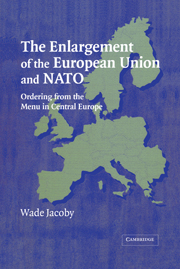Book contents
- Frontmatter
- Contents
- List of Tables, Graph, and Figures
- Preface and Acknowledgments
- Introduction: Ordering from the Menu in Central Europe
- 1 Emulation as Embedded Rationalism
- 2 Emulation as Rapid Modernization: Health Care and Consumer Protection
- 3 Emulation Under Pressure: Regional Policy and Agriculture
- 4 The Struggle for Civilian Control of the Military
- 5 Military Professionalization in War and Peace
- 6 Using Theory to Illuminate the Cases
- 7 Synthesis and Sequence: Juxtaposing Theory Traditions
- 8 Extensions and Conclusions
- Appendix: Selected List of Persons Interviewed
- Works Cited
- Index
2 - Emulation as Rapid Modernization: Health Care and Consumer Protection
Published online by Cambridge University Press: 06 July 2010
- Frontmatter
- Contents
- List of Tables, Graph, and Figures
- Preface and Acknowledgments
- Introduction: Ordering from the Menu in Central Europe
- 1 Emulation as Embedded Rationalism
- 2 Emulation as Rapid Modernization: Health Care and Consumer Protection
- 3 Emulation Under Pressure: Regional Policy and Agriculture
- 4 The Struggle for Civilian Control of the Military
- 5 Military Professionalization in War and Peace
- 6 Using Theory to Illuminate the Cases
- 7 Synthesis and Sequence: Juxtaposing Theory Traditions
- 8 Extensions and Conclusions
- Appendix: Selected List of Persons Interviewed
- Works Cited
- Index
Summary
The “return to Europe” was to mean, in domestic terms, the establishment of “normal,” understood as West European-style institutions: a pluralist liberal-democratic political system and a market economy which could offer both consumer affluence and a developed welfare state.
(Batt 1997: 161)To focus on emulation, we must first clear up some misconceptions about CEE institutional change. Some see emulation as a straightforward tool for well-informed elites to quickly set up the right institutions following prevailing “best practices” (Memmelaar 1990). Others characterize it as the mindless and unreflective mimicry of those new elites who lack their own institution-building capacities (Krygier 2002). Still others emphasize precisely the robust institutional visions of the CEE opposition leaders who emerged from the communist era and deny that these elites had any use for emulation at all (Greskovits 1998). Misconceptions about timing also vary. For some observers, emulation was used only in a brief flurry after 1989, while others take roughly the opposite approach and suggest it was not used until NATO or EU conditionality forced the CEE states to adopt their practices. These are misconceptions not because they are simply wrong — for all are partially true — but because they cannot capture the range of things going on under the deceptively simple cover of “emulation.”
This chapter focuses on two areas in which the EU had little leverage.
- Type
- Chapter
- Information
- The Enlargement of the European Union and NATOOrdering from the Menu in Central Europe, pp. 41 - 76Publisher: Cambridge University PressPrint publication year: 2004



